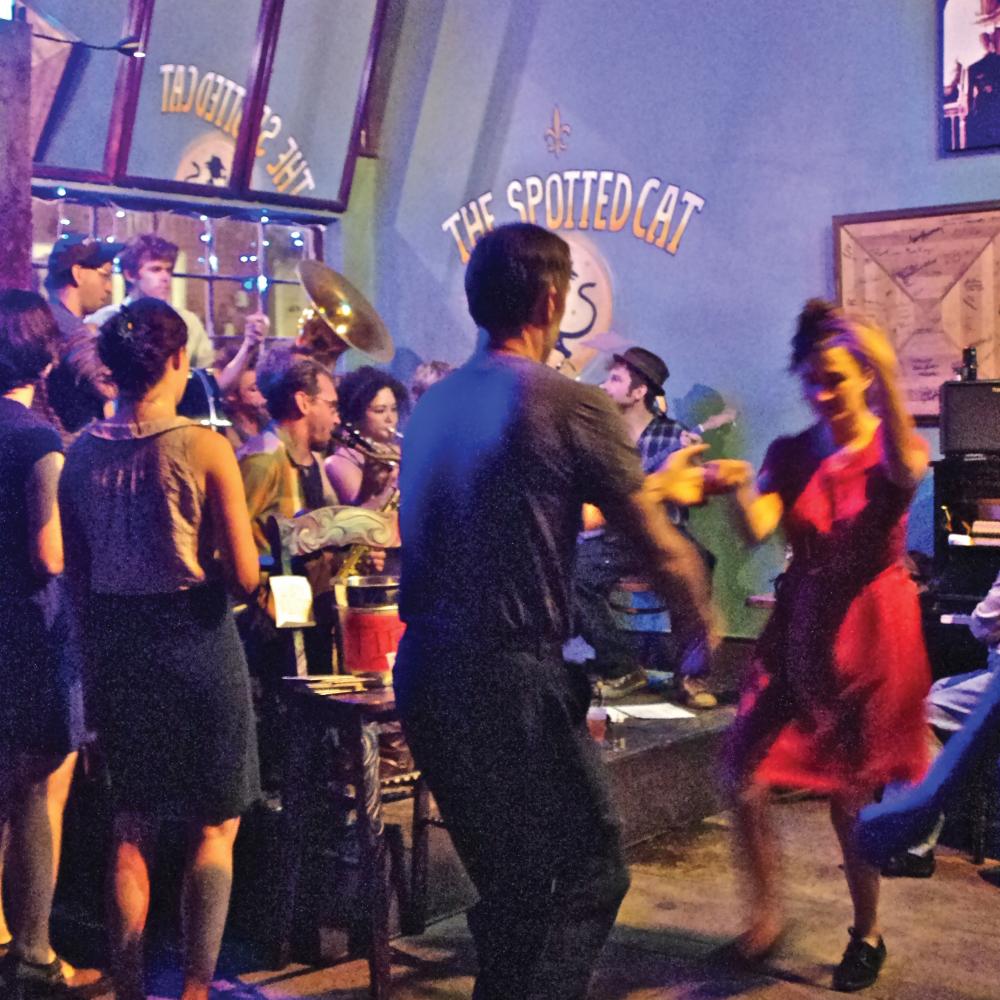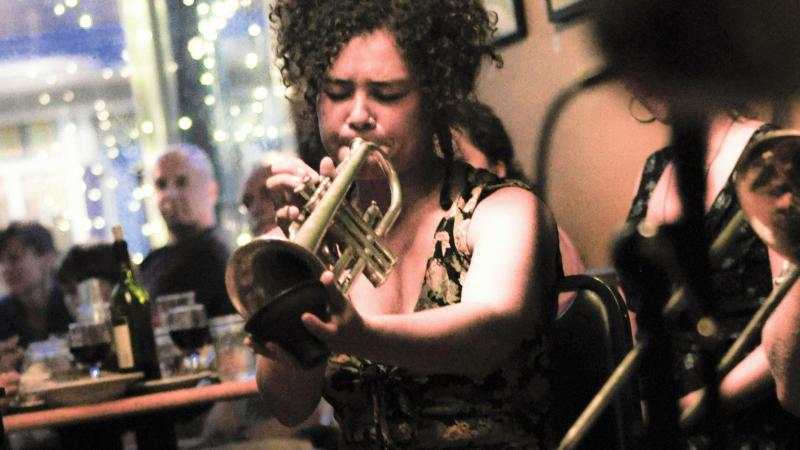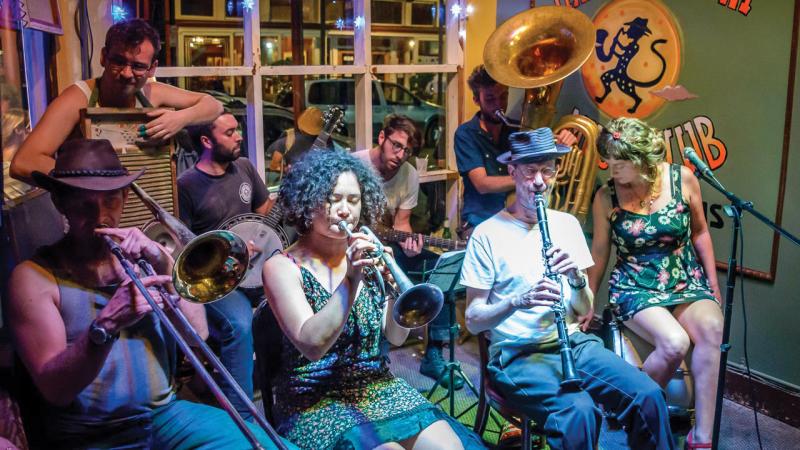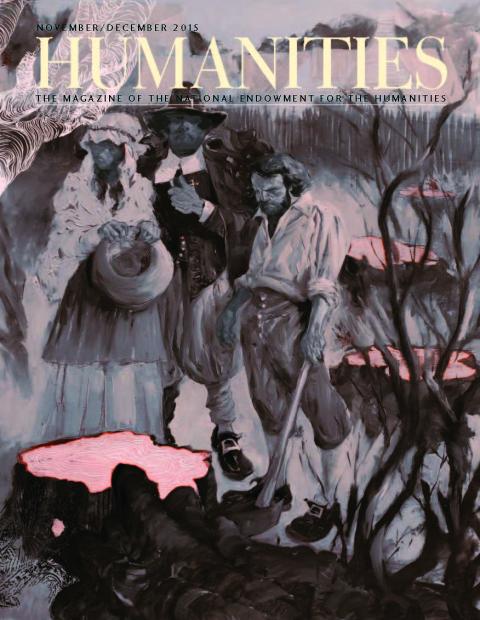One summer night in 1914, a band of New Orleans musicians on cornet, trombone, clarinet, violin, guitar, and stand-up bass showed up, far from home, at Doyle’s boxing ring in Los Angeles for a well-attended lightweight fight. Woodrow Wilson was president, Henry Ford had recently unveiled the first mass-production assembly line, and two weeks earlier World War I had broken out in Europe.
Between bouts at Doyle’s, the cornetist got up on a bench and started blowing. Immediately, “the crowd stood up as one man and shouted for us to get in the ring, and screamed and screamed,” recalled George Baquet, their clarinet man.
Baquet was a formally trained musician, who nearly a decade earlier on New Orleans’s South Rampart Street had had a “conversion experience” when he heard the legendary First Man of Jazz, Buddy Bolden, play the cornet. “After that, I didn’t play legitimate so much,” Baquet recalled.
He and his buddies, billing themselves as the Creole Orchestra from New Orleans, had wandered slowly into L.A. and pulled what gigs they could. A Los Angeles Record reporter described one of their shows: “In a corner of the café a strange orchestra was producing . . . a rhythm so enticing that the temptation to dance was almost overwhelming.”
A talent booker heard the rhythm at Doyle’s and asked the guys to form an act, “he did not care what, so long as he had that music.” Soon they were blowing the “uncanny sounds” of inchoate New Orleans jazz on vaudeville stages around the country.
Not long after, Einstein published his field equations, linking planetary pull with space-time. The coming of swing rhythm around this time seems more than coincidental. Now music was released from gravity.
A century later, the New Orleans parade beat has, like grass, broken through sidewalks of cities across the globe. In the streets, dance halls, and late-night venues of New Orleans, New York, Philadelphia, Austin, Sacramento, Denver, Chicago, Washington, D.C., Vancouver, London, Paris, Edinburgh, Stockholm, and Tokyo, the music has reincarnated in the young bodies and souls of today’s millennial generation—musicians and hoofers alike.
Notices from the last two years show that this trend, first observed more than a decade ago, has swollen to massive proportions. The Guardian reported that with “the recent resurgence of swing music . . . dance floors all over the country seem to be filling with new Lindy Hoppers.” In Vanity Fair, the New York jazz journalist Will Friedwald wrote, “I find that I can go hear a twenties-style band, almost inevitably made up of musicians born well after 1980, playing somewhere in the city virtually every night of the week.” Offbeat has observed that in New Orleans, “more traditional bands may play regularly today than at any previous time in jazz history,” and audiences “have swelled into crowds of enthusiastic young people who turn out in droves from all over the world.”
What’s going on? Why are twenty- and thirty-somethings suddenly playing and dancing to music older than their grandparents?
On a Friday night at Boston Swing Central, hiding among industrial back streets, I watched two hundred Lindy Hoppers rock-stepping and swinging-out, smiles plastered on their faces, the Crescent City polyphony of the Baby Soda jazz band driving them on. A young dancer told me, “It’s a religious experience, I am so in the moment.” Baby Soda coleader Peter Ford summed it up: “You’ve got these 25-year-olds throwing each other around the room with reckless abandon and swing.”
Baby Soda’s website describes the band as “on the forefront of a new movement loosely known as street jazz.” But the “movement” never went away—just into slumber. A century ago, “ragged” music played out on New Orleans streets amid marching brass bands, dance hall turkey-trots, street-corner honkers, and horse-pulled band wagons. For African Americans, it was about confidence and kinship—standing as humans under the sun.
Now, on the hundred-year marker, I find myself thinking that the millennials who are playing and dancing to swing rhythm are experiencing those same, oddly joined feelings of freedom and connectedness. Talk to them and you hear one word coming up again and again: community.
April 2014, French Quarter Festival in New Orleans. The band was Tuba Skinny, eight ragtag kids in their late twenties and early thirties playing jazz and jug-band music tight as a clock and fueling a floor full of Lindy Hoppers into a jumping groove. A dancer named Les said, “When people are dancing, everyone smiles. You can see the joy in their faces.” Listeners thronged by the hundreds.
The band has roots going back to New York in 2006, just after Hurricane Katrina, when a 28-year-old University of Michigan music-school grad named Ben Polcer met a braying clarinetist named Michael Magro. He played “the same kind of music I heard growing up,” noted Polcer in Jim Flynn’s book Sidewalk Saints. “But it was grittier, and at the same time it also had this kind of sanctified feel, like church music. I was like, ‘damn, I wanna do that.’”
Billing themselves as the Loose Marbles, Polcer and Magro moved to New Orleans and began playing around the French Quarter. “There’s something about New Orleans where I just get so caught up in the moment,” Polcer remarked in Saints. This computes: Jazz players always look for that moment, the “pocket,” the groove.
Polcer once told a New Yorker writer, “I like rock ‘n’ roll. We all like rock ‘n’ roll. But jazz is special. To play it well, you really have to listen to each other.” Contrast that with, say, the Rolling Stones, who have said that onstage they can’t hear one another.
Swing rhythm—the jazz heartbeat—comes from the early black Sanctified and Baptist churches. In the fabled plantation “ring shouts,” in their brush arbors, black folk could forgo the white man’s litany and find community, sharing the loneliness, howling in freedom to the heavens. One old slave preacher recalled a Georgia camp meeting: “There is a joy on the inside and it wells up so strong that we can’t keep still. It is fire in the bones. Any time that fire touches a man, he will jump.”
The rhythm likely goes back to African work song, an example of coordinated group action. Folklorist Roger D. Abrahams wrote that plantation corn-shucking songs expressed “intense feelings as they were experienced by the whole group moving together in common purpose.”
In New Orleans, that sense of common purpose shows up in the “second line” brass band funeral parades, where whole neighborhoods side-step and gyrate alongside the “first line” of marching musicians. Writing in JazzTimes, Geraldine Wyckoff remarked, “When a brass band really starts kicking in and the club members and second liners get down with the groove, dancing for all they’re worth . . . , one can become lost in time and space, swept up in the rhythms and joyfulness.”
Polcer and Magro began pulling in all manner of musicians, some with training, some with just passion. One of them was 32-year-old Shaye Cohn, granddaughter of the renowned tenor saxophonist Al Cohn and current leader of Tuba Skinny. Growing up in Brookline, Massachusetts, Cohn practiced classical piano for 12 years, winning awards. She studied music at New York University. But tiring of that “lonely, stressful lifestyle,” she walked away. “I didn’t think I’d be playing any other instruments ever again,” she told me.
She drifted down to New Orleans, where she connected with a fiddler who “played klezmer and old-time, Appalachian, and gypsy music from Romania.” It was a reawakening, “a new world of music for me,” she said.
She explained: “One thing really important to the Loose Marbles was ensemble playing. When I first started with them, I was playing second trumpet. So I had to work to find a voice where I could fit in. It taught me to play very simply, and to listen.”
Early jazz revolves around the ensemble—the whole band sound. (Modern jazz centers on the solo.) It has been called the sound of democracy, an example of e pluribus unum or “out of many” voices “one” song, a music that depends on musicians listening to each other, and working toward, again, a common purpose.
Eight years after arriving in the Big Easy, Cohn leads one of the most synchronous yet rootsy bands in the traditional jazz idiom. On tour last summer, Tuba Skinny played 24 different venues in California, Maine, and New York.
On the Lindy Hop’s late 1920s emergence, Canadian music professor Howard Spring has written, “The most direct factor was the dynamic relationship between musicians and dancers.” And, he added, “the dance set off changes in the music.”
The Lindy Hop is swing music made visible. As with the cornet-clarinet-trombone polyphony, the dance-player connection brings the ecstasy. If everyone pushes the beat just right, the moment swings.
They knew it back in the day. Albert Nicholas, a Crescent City clarinetist who played with Joe “King” Oliver, said, “The band played full but no blasting. Joe wanted to hear those feet on the floor; the feet of the dancers. He’d say, ‘When you don’t hear those feet, you’re not playing music; you’re making noise.’”
And they know it today. In Why New Orleans Matters, Tom Piazza has written, “Mac Rebennack, better known as Dr. John, once told me that when a brass band plays at a small club back up in one of the neighborhoods, it’s as if the audience—dancing, singing to the refrains, laughing—is part of the band. They are two parts of the same thing.”
So—the beat goes into the feet and connects everyone who is present to each other, even as it induces a temporary state of splendid freedom. Think of a child on a swing set. At the top of the arc, there’s a moment between going up and coming down. The child floats, buoyant. He’s found release from gravity—and from all that word implies. And gravity, as Einstein showed a century ago, is a warp in space-time.
Beyond the century-old scientific and musical parallels, there are socioeconomic ones. In his landmark study Bowling Alone, the sociologist Robert Putnam has seen a decline in our social capital, that is, in our connections with others. In the late nineteenth and early twentieth century, massive industrialization and immigration split up families and neighborhoods. Today, Putnam writes, we have again been “overtaken by a treacherous rip current. Without first noticing, we have been pulled apart from one another and from our communities.”
By contrast, Bruce Boyd Raeburn, of Tulane University’s Hogan Jazz Archive, described the early years of jazz this way: “New Orleans players held a virtual monopoly on the syntax of collective improvisation, a musical give-and-take which resembled a street-corner conversation with everyone trying to get a word in edgewise.”In a time of political polarization, it makes sense that music and dancing that connects people should seem especially exciting, an answer to some of the estrangement and alienation we feel off the dance floor.
The 32-year-old trumpeter/vocalist Bria Skonberg, a bright light in the jazz resurgence, has played major NYC jazz venues and toured ceaselessly around North America. “Coming out of the ‘next great depression,’’’ she told me, “the music might be a way to bring people together. The energy is that much more important in dark times.”
It is the human quest, from the dark into the light. Writing of Emancipation and the spiritual “Go Down Moses,” the great New Orleans reed man Sidney Bechet recalled:
It was years they’d been singing that. And suddenly there was a different way of singing it. You could feel a new way of happiness in the lines. All that waiting, all that time when that song was far-off music, waiting music, suffering music; and all at once it was there, it had arrived. It was joy music now.
So now, ten years post-Katrina, what’s with the swing jazz resurgence? Tom Piazza may have hit it: “Most funeral traditions in our society are there to remind us that we are dust, and to dust we shall return. In New Orleans the funerals remind us that Life is bigger than any individual life, and it will roll on, and for the short time that your individual life joins the big stream of Life, cut some decent steps, for God’s sake.”




